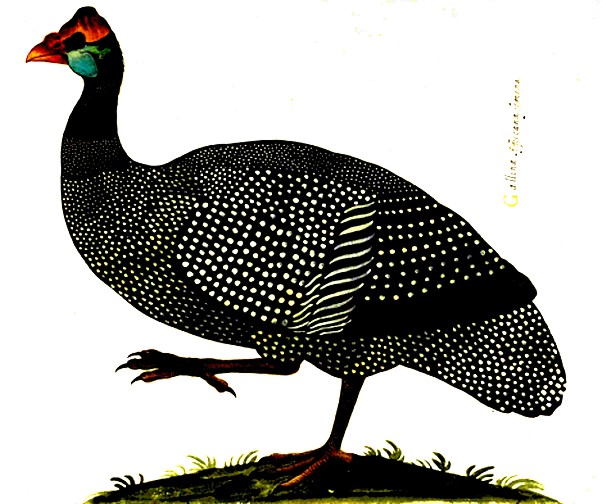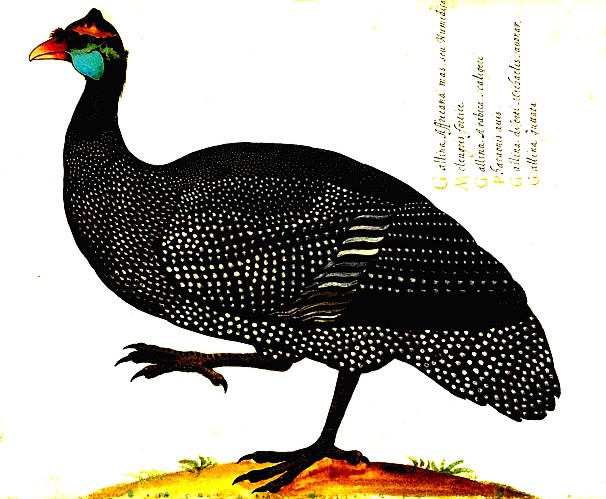Lessico
Numida meleagris
Faraona - Gallina di Faraone
Gallina di Numidia
Caratteristiche cefaliche di alcuni appartenenti al genere Numida
Uccello dell’ordine dei Galliformi, famiglia
Fasianidi, sottofamiglia Numidini che trae il nome della specie - meleagris – da Meleagro![]() , eroe della mitologia greca, figlio di Eneo re di
Calidone in Etolia e di Altea
, eroe della mitologia greca, figlio di Eneo re di
Calidone in Etolia e di Altea![]() .
.
La sottofamiglia dei Numidini è composta, secondo Bernhard Grzimek, da cinque generi:
Phasidus: Phasidus niger – Faraona nera
Agelastes: Agelastes meleagrides – Agelaste
Guttera: Guttera plumifera
e
Guttera pucherani (Numida crestata)
Acryllium: Acryllium vulturinum – Numida vulturina
Numida: Numida meleagris – Gallina di Numidia![]() o
Gallina di Faraone
o
Gallina di Faraone
La Numida meleagris è stata suddivisa in diverse sottospecie che presentano l’elmo corneo di foggia assai diversa da una sottospecie all’altra. Grzimek elenca le seguenti: meleagris, sabyi, galeata, mitrata, major.
La nostra attuale faraona domestica sarebbe la forma d’allevamento della Numida meleagris galeata originaria dell’Africa occidentale, introdotta in America e in Europa dai Portoghesi all’epoca delle grandi scoperte geografiche.
Nell’antichità venne dapprima addomesticata solo la sottospecie marocchina – Numida meleagris sabyi, più tardi i Romani importarono in Europa anche la sottospecie dell’Africa nordorientale – Numida meleagris meleagris.
Descrizione
della sottospecie da allevamento
Numida meleagris galeata
La sottospecie da allevamento della gallina di Faraone raggiunge una mole discreta - sino a 2 kg - ed è caratterizzata da testa e collo parzialmente nudi e ricoperti di pelle biancastra con alcune appendici cutanee. A livello della base del becco, che appare ricurvo, si osservano due bargigli rossi, più grandi e spesso attorcigliati nel maschio. Sul capo, al posto della cresta, si trova un astuccio corneo a forma di piccolo elmo sorretto da un processo osseo. Il corpo ha un profilo particolare ed è coperto da penne che presentano piccole e regolari macchie bianche di forma rotonda. Le zampe portano quattro dita; manca lo sperone.
La faraona è buona produttrice di carne che ha caratteristiche organolettiche peculiari. Limitata è invece la produzione di uova, del peso di 40-45 g. La femmina non è una buona covatrice. Lo sviluppo embrionale dura 27 giorni. I pulcini sono per breve tempo ricoperti di peluria, presto sostituita dalle penne giovanili. Non esiste un pronunciato dimorfismo sessuale; il maschio è più alto. La femmina appare, invece, tozza ma più pesante. Di quando in quando le faraone strepitano incessantemente: il grido più noto è un forte ciké-ciké-ciké.
|
Guinea
Fowl All authors agree that the domestic guinea fowl
was derived from the helmeted guinea fowl - Numida meleagris - of Africa. There were at least several
independent domestications involving more than one subspecies.
Present-day commercials stocks were probably all derived from the West
African subspecies Numida
meleagris galeata. Wild
Species Classification.
Belshaw (1985) has classified guinea fowl as order Galliformes,
family Numididae, but Howard and Moore (1984) placed them in
family Phasianidae and subfamily Numidinae. There are
four genera (Agelastes, Guttera, Numida, Acryllium) comprising seven species.
Genus Numida consists of a
single polytypic species meleagris
and 22 subspecies. Crowe (1985) has used a simpler classification
of Numida meleagris involving
nine well-marked subspecies which fall into three groupings: West
African - N.
m. galeata and
sabyi Description.
Crowe (1985) described helmeted guinea fowl as opportunistic omnivores
which inhabit open savannah and mixed savannah-bush. They are
gregarious in the nonbreeding season, and monogamous as breeders.
Females, especially in the breeding season, emit a characteristic
two-note ‘buck-wheat’ call; males respond with a single note; both
sexes have a rattling alarm call. Males are slightly larger than
females but otherwise they exhibit almost no sexual dimorphism. Adult
body size ranges from 0.7-2.0 kg (Long, 1981). The crown of the head
carries a bony helmet with a horny sheath, and a pair of wattles hang
from the gape. The nares are exposed, but in subspecies inhabiting hot
dry areas the nares are surrounded with warts or cartilaginous
bristles. Blood supply to the helmet, wattles, and cere may have
importance in thermoregulation. The legs are long and powerful,
lacking a spur. Plumage is monotypic. The ground color is black, with
white spots intermeshed with white vermiculation; the spots on the
outer margins of the secondaries are enlarged to form bars. Incubation
time is 27-28 days, and clutch size varies from 6-10 eggs. According
to Crowe (1985), the West
African galeata subspecies is small to medium-sized, and has a naked cere
and rounded red wattles. N. m.
sabyi is isolated in Morocco and differs very little from N. m. galeata. The East African meleagris and somaliensis subspecies
are medium-sized, they have long bristles on the cere, and rounded
blue wattles. The Central-South African group are relatively large
birds. They have a naked cere (except for N.
m. papillosa which has warts around the rim) and triangular-shaped
blue wattles with red tips. Distribution.
Helmeted guinea fowl occur naturally throughout most of sub-Saharan
Africa. There is an isolated northern population - N.
m. sabyi -
in Morocco (Crowe, 1985). Many
introductions have been made, some involving wild birds and some
involving domestic stocks, and reintroductions have been made to areas
of Africa where they had been exterminated (Long, 1981). The
population in Yemen was probably introduced long ago; it is similar to
the East African subspecies, for which some authors use the
designation ptilorhyncha. The
population in Malagasy was probably also introduced; it is classified
as N. m. mitrata. Many
oceanic islands have been stocked, not all of them successfully.
Repeated introductions in New Zealand, Australia, and the United
States met with general failure. There were introductions to most
islands of the Caribbean, sometimes with wild birds and sometimes with
domestic stocks which became feral. Some of these introductions were
made in the 16th century and others arrived as live provisions on
African slave ships. Populations flourished but many later became
extinct because of hunting pressure and predation by the introduced
mongoose. Viable wild or feral populations persist in Haiti, Dominican
Republic, and Cuba. Domestication
And Early History It
is likely that many separate domestications have occurred in many
separate places over time. According to Crowe (1985), wild populations
of Numida meleagris readily
become commensals of man, increasing in numbers and distribution
because of the water, roosting, and feed resources resulting from
human activity. However, unlike the situation for other poultry
species, there is little indication in the historical record that
guinea fowl were utilized other than as a human food resource. Belshaw
(1985) makes only brief mention of their use in religion and folklore
and of feathers in decoration. Eggs were probably of first importance
and edible meat was secondary. Information
on history of domestication within Africa is scanty and, except for
Egypt, depends on oral history. Belshaw (1985) stated that early
domestication had occurred in two areas - in southern Sudan and in West Africa - but
the dates are not certain. The process of domestication probably
continues even now. Guinea fowl were depicted in a mural from the
Egyptian fifth dynasty about 2400 B.C. but there is no evidence that
the birds were domesticated then. They also appear in archaeological
remains at Farnak dated from about 1900 B.C. and at Thebes (1570-1300
B.C.). It is supposed that they were artificially hatched and reared
in large numbers concurrently with chickens during that period (Belshaw,
1985) but evidence is lacking; chickens are known to have been in
Egypt at that time, but they were absent from the archaeological
record in subsequent centuries, not appearing again until about 600
B.C. under Greek and Persian influence. Guinea
fowl were well-known to the Greeks and Romans in classical times. They
were mentioned by Ovid, Aristotle, Pliny, Varro, and Columella.
According to Zeuner (1963), the Greeks called the bird melanargis
(black-silver) which was corrupted to meleagris
and became associated with Greek mythology. Moubray (1854) related
that story: “... the
Meleagrides, the sisters of Meleager ...
who
was cruelly put to death, bewailing the death of their unfortunate
brother, were metamorphosed into Guinea-fowls, the shower of tears
they shed bedecking their otherwise sable plumage with white spots ...“.
Wood-Gush
(1985) indicated that the Moroccan subspecies N. m. sabyi was kept as a sacred bird on an Aegean island in the
fourth century B.C. The Romans later knew this bird as the Numidian
fowl. They also had birds of the East African subspecies which they
called Meleagris and which they preferred. Both terms were
eventually utilized by Linnaeus in formal naming of the genus and
species. Guinea fowl were highly regarded as a food item by the Romans
who must have distributed them throughout the Roman Empire. Zeuner
(1963) mentioned bones of guinea fowl discovered in a Roman camp in
the Taunus Mountains of West Germany, and Belshaw (1985) refers to a
leg bone carrying a metal ring found in ruins of the Roman town of
Silchester in England. With
decline of the Roman Empire, guinea fowl seem to have disappeared from
Europe leaving almost no trace in the historical record. Mongin and
Plouzeau (1984) refer to possible exceptions. They may have persisted
in Greece and Italy, since Wood-Gush (1985) has noted a reference to
the keeping of guinea fowl in Athens during the tenth century. The
Portugese of the late 16th century are generally credited with
rediscovering guinea fowl on the west coast of Africa, from where the
bird acquired its common name. The term poule
de Guinée may have been used first in 1555 by Belon (Mongin and
Plouzeau, 1984). The Portuguese took these guinea fowl to Europe, to
the Americas, and elsewhere. Diffusion through Europe was probably
concurrent or perhaps slightly in advance of turkey introductions,
resulting in unfortunate confusion of names and identity of the two
species which persists in their scientific nomenclature. Nearly
all modern guinea fowl are likely to have been derived from Portuguese
introduction of the West African subspecies Numida meleagris galeata. There are indications that new
commercial hybrids may involve blends of several subspecies (Belshaw,
1985) but documentation in the technical literature is lacking.
Domestic birds in Malagasy and those introduced from there to other
localities may be domesticated Numida
meleagris mitrata. Those of eastern Africa are likely to be
domesticates of meleagris and somaliensis subspecies,
and those of the Mediterranean area may still bear traces of both East
and West African subspecies. |

Gallina Affricana femina
acquarelli![]() di Ulisse Aldrovandi
di Ulisse Aldrovandi
Gallina Affricana mas
